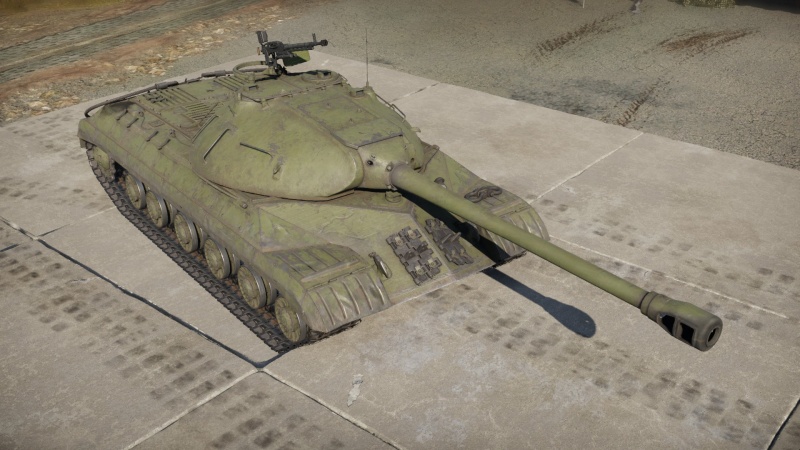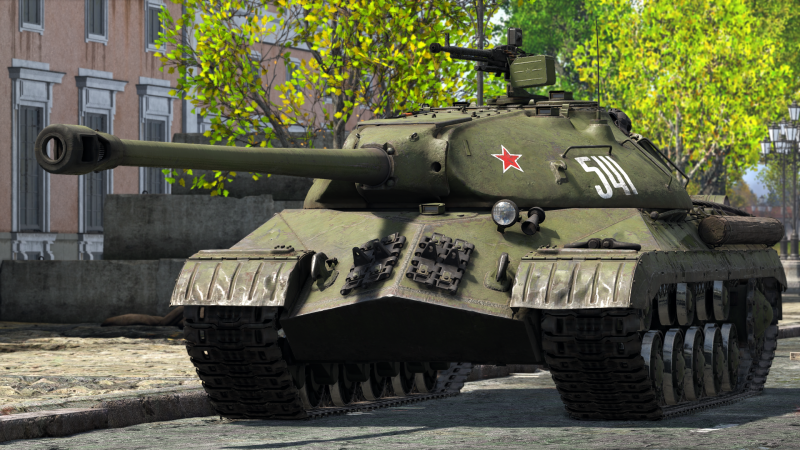IS-3
Contents
Description
The IS-3 is the third variant of the IS heavy tank family. The IS-3 featured a revolutionary front hull and turret design that would become the trademark of all postwar Soviet tanks until this day. Since the IS-3 differed from earlier designs in many ways, a thorough retooling was required for the first time. This took time, and the first three IS-3s rolled out of the factory in May 1945, ready to go into service in Germany under an independent Guards Battalion. When they arrived, though, the peace treaty had already been signed. Many more IS-3s were ready by the time of the August invasion of Manchuria, but there is little indication that they took part in these events. In the end, the IS-3 saw little action other than being stationed on numerous fronts during the Cold War. Due to a variety of difficulties, production was halted, and it was replaced with the IS-4, prototypes IS-6, IS-7, and, finally, the IS-8 (renamed T-10 after Stalin's death). Because of their lack of mobility, the Russians came to the same conclusion as their Western counterparts about heavy tanks. After the first MBT family was launched in 1953, this class of heavy tank was also abandoned, similar to those in the West. Inadvertently, the IS-3 ended up became an influential tank design due to their appearance during the 1945 Victory Parade in Berlin has startled the Western Allies and causing them to develop numerous tank design to directly counter it, such as the American M103 and the British FV4005.
Introduced in the Closed Beta Test for Ground Forces before Update 1.41, the IS-3 is armed with the same 122 mm D-25T tank gun as earlier IS heavy tank variants, which has incredible destructive power. Once the BR-471D ammunition becomes available, the weapon's efficacy increases dramatically, increasing its penetration from 207 to 230 mm. The IS-3 will face several other heavy tanks with huge, slow-reloading guns in its ranks, establishing an equal playing field. Regardless, be wary of nimble, fast-firing, lightly armoured flanking opponents. Despite being relatively light for a heavy tank, the IS-3 has poor mobility. It features a 671-horsepower engine, which makes the vehicle feel slow while attempting to initiate a turn from both a standstill and when moving. Its acceleration is likewise lacking; nonetheless, it has a reasonably high top speed and will usually reach it regardless of the surface it is driving on. Fortunately, as with many late Soviet heavy tanks, the IS-3's reverse speed is highly respectable, giving it the time it needs to back out of dangerous circumstances to reload or repair. Despite what some may expect from such a massive tank, the reverse gears and low forward gears allow the vehicle to drive up unexpectedly steep slopes.
The most noticeable differences between the preceding variants are the revised turret and the sharply slanted 'pike' nose. The front is not just slanted but also relatively thick, with 110 mm of armour on both the top and bottom, oriented at 54°, -56°, and 54°, respectively. The IS-3, like previous variants, has fairly mediocre side and rear armour, therefore, angling should be avoided. The turret has been modified to be considerably stronger than previous variants, with more angling, a much smaller flat region around the mantlet, and significantly thicker casting. Trap shots and turret ring penetration are possible; however, they can be mitigated by lowering the tank gun and protecting the vulnerable locations. The IS-3 is a 'breakthrough' tank that excels at close-range, front-on combat where flanking is unlikely and players can take advantage of the strong frontal armour and reverse speed to deliver surprising blows to the enemies.
General info
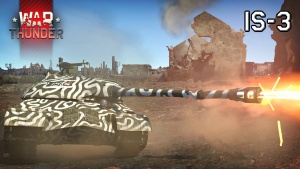
Survivability and armour
Armour type:
- Rolled homogeneous armour (Hull, Turret roof)
- Cast homogeneous armour (Turret)
| Armour | Front | Sides | Rear | Roof |
|---|---|---|---|---|
| Hull | 110 mm (54-56°) Front glacis 110 mm (54°) Lower glacis |
90 mm (0-40°) Top 20 mm (60°) Bottom |
60 mm (47°) Top 60 mm (41-42°) Bottom |
20 mm |
| Turret | 250 mm (1-78°) Turret front 100 + 250 mm (9-79°) Gun mantlet |
75-220 mm (33-69°) | 70-120 mm (22-52°) | 20 mm Front, Hatch roof 40 mm Center 75 mm Sides |
Notes:
- Suspension wheels are 20 mm thick while tracks are 30 mm thick.
- The thickest armour of the tank is at the front – the "beak" at the front of the hull raises the effective thickness of the armour from 110 to around 180 – 200 mm, depending on the exact spot.
- The turret front of the IS-3 is an also fairly well armoured, with 250 mm of heavily sloped armour equating to around 400 mm effective thickness.
- Turret side armour is not equal throughout its length. In the side middle, it is 130 mm, then bordering the rear armour is 150 mm thick.
- Gun mantlet side and bottom are boosted by the 250 mm of the turret front, whereas the top of gun mantlet has no armour behind it.
- Side armour of the hull has an additional 5 mm of sheet metal on above the suspension area.
- Turret ring is 200 mm thick with a 20 mm "collar" covering the front and sides.
- Upper half of the side armour is at a very steep angle, meaning conventional rounds will simply bounce
Mobility
| Game Mode | Max Speed (km/h) | Weight (tons) | Engine power (horsepower) | Power-to-weight ratio (hp/ton) | |||
|---|---|---|---|---|---|---|---|
| Forward | Reverse | Stock | Upgraded | Stock | Upgraded | ||
| Arcade | Expression error: Unexpected * operator. | 671 | Expression error: Unexpected round operator. | __.__ | |||
| Realistic | 460 | Expression error: Unexpected round operator. | __.__ | ||||
The mobility and speed of the IS-3 is decent, and is somewhere between other heavy tanks of the same tier and mediums tanks of the same tier. The IS-3 drives very similar to its predecessors the IS-1 and IS-2. Whenever the IS-3 turns at all, much of the speed of the tank is instantly lost, making the hull turn rate lacklustre, especially without neutral steering. This is, of course, akin to those previously mentioned predecessors.
Modifications and economy
Armaments
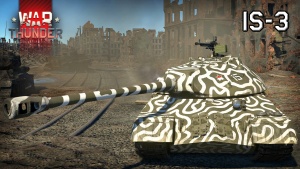
Main armament
The IS-3 carries a heavy 122 mm D-25T cannon, the same weapon mounted on the IS-2 and IS-4M, as well as other variants of the IS-3. This cannon, based on a heavy howitzer, is a highly-effective weapon capable of hitting extremely hard. However, it has an extremely slow reload speed, and rather poor gun depression.
The D-25T cannon fires large 122 mm shells, which are relatively effective against most targets at the IS-3's BR. However, the cannon's effectiveness is hampered by two main drawbacks - relatively bad gun handling (particularly the gun depression and turret rotation speed), and the ridiculously long reload rate. Firstly, the turret has a weak gun depression of just 3 degrees as well as a slow rotation speed, which can hamper the IS-3's ability to get its gun on target quickly and efficiently. Secondly, and more importantly, the IS-3 has a massive gun reload of 20+ seconds. This means that the IS-3 is more suited for a longer-ranged, "heavy fire support" role, as it makes use of the gun's massive punching power without running into situations where the IS-3's gun cannot reload quickly enough to return fire. However, these two drawbacks are compensated for by the IS-3's powerful ammunition, capable of dealing with most targets at its BR. While it retains the 3 shell types found on the previous IS-2, the IS-3's gun also gets access to the BR-471D APCBC shell. This shell gets less TNT filler than the other shells, but gains improved penetration of 230 mm at point-blank range. This shell is capable of frontally-penetrating most tanks at the IS-3's BR. However you should not underestimate the BR-471B APHEBC shell either, since it actually has higher angled penetration than the BR-471D.
| 122 mm D-25T | Turret rotation speed (°/s) | Reloading rate (seconds) | |||||||||||
|---|---|---|---|---|---|---|---|---|---|---|---|---|---|
| Mode | Capacity | Vertical | Horizontal | Stabilizer | Stock | Upgraded | Full | Expert | Aced | Stock | Full | Expert | Aced |
| Arcade | 28 | -3°/+20° | ±180° | N/A | 7.3 | 10.1 | 12.2 | 13.5 | 14.4 | 26.00 | 23.00 | 21.20 | 20.00 |
| Realistic | 5.4 | 6.3 | 7.7 | 8.4 | 9.0 | ||||||||
Ammunition
| Penetration statistics | |||||||
|---|---|---|---|---|---|---|---|
| Ammunition | Type of warhead |
Penetration @ 0° Angle of Attack (mm) | |||||
| 10 m | 100 m | 500 m | 1,000 m | 1,500 m | 2,000 m | ||
| BR-471 | APHE | 205 | 201 | 182 | 161 | 143 | 127 |
| BR-471B | APHEBC | 205 | 203 | 192 | 178 | 166 | 155 |
| BR-471D | APCBC | 230 | 227 | 215 | 200 | 186 | 173 |
| OF-471 | HE | 37 | 37 | 37 | 37 | 37 | 37 |
| Shell details | ||||||||||||
|---|---|---|---|---|---|---|---|---|---|---|---|---|
| Ammunition | Type of warhead |
Velocity (m/s) |
Projectile mass (kg) |
Fuse delay (m) |
Fuse sensitivity (mm) |
Explosive mass (TNT equivalent) (g) |
Ricochet | |||||
| 0% | 50% | 100% | ||||||||||
| BR-471 | APHE | 795 | 25 | 1.2 | 19 | 246.4 | 47° | 60° | 65° | |||
| BR-471B | APHEBC | 795 | 25 | 1.2 | 19 | 246.4 | 48° | 63° | 71° | |||
| BR-471D | APCBC | 800 | 25 | 1.2 | 19 | 192.5 | 48° | 63° | 71° | |||
| OF-471 | HE | 795 | 25 | 0 | 0.1 | 3,600 | 79° | 80° | 81° | |||
Ammo racks
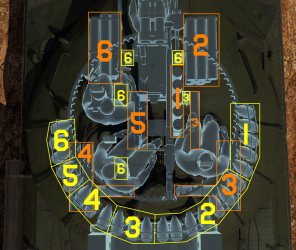
| Full ammo |
1st rack empty |
2nd rack empty |
3rd rack empty |
4th rack empty |
5th rack empty |
6th rack empty |
Visual discrepancy |
|---|---|---|---|---|---|---|---|
| 28 | 23 (+5) | 17 (+11) | 13 (+15) | 10 (+18) | 8 (+20) | 1 (+27) | No |
The D-25T cannon fires two-piece ammunition that are stored all around the crew compartment. The majority of the projectiles are found lining the sides and rear of the turret while the majority of the propellant found in the hull, with two large piles flanking the driver and a few kept on the hull floor and rear. Next to the cannon breech on the loader's side is a small ready rack containing 5 propellant charges, with the 5 accompanying projectiles found to the loader's right against the turret side. The time it takes the loader to load one round into the ready rack from the stowage racks is about 21 seconds.
- Recommended ammo load is 12, which empty all of the racks but racks 1 and 6.
- Ammo Rack 1 is a ready rack, and takes priority in being filled at the beginning of the battle, then fills racks 6 through 2.
- Full reload speed will be realized as long as ammo exists in the ready racks. If all three ready racks are empty, a penalty to reload speed will occur.
- Simply not firing when the gun is loaded will load ammo from racks 2-6 into rack 1, as long as there is ammo in racks 2-6. Firing will interrupt the loading of the ready racks.
Machine guns
The IS-3 carries two secondary machine guns, being a 12.7 mm DShK machine gun on the turret roof as well as a coaxial 7.62 mm DT machine gun. The DT machine gun is relatively ineffective, as its small calibre prevents it from doing any sort of real damage against targets with any armour. As well, the coaxial mounting prevents the DT from firing at air targets effectively. The DShK, on the other hand, can be a more potent weapon when used against lightly-armoured vehicles or aircraft. The gun can penetrate the sides/back of some IFVs/SPAAs/light-armoured vehicles, and also has good firing angles allowing it to engage enemy aircraft and helicopters.
| 12.7 mm DShK | ||||
|---|---|---|---|---|
| Mount | Capacity (Belt) | Fire rate | Vertical | Horizontal |
| Pintle | 300 (50) | 600 | -4°/+85° | ±180° |
| 7.62 mm DT | ||||
|---|---|---|---|---|
| Mount | Capacity (Belt) | Fire rate | Vertical | Horizontal |
| Coaxial | 2,016 (63) | 600 | N/A | N/A |
Usage in battles
The IS-3, continuing the tradition of the Soviet IS line of heavy tanks, sports a powerful 122 mm cannon, strong frontal armour and reasonable mobility for its class. As with its predecessors, it excels at dispatching anything it can penetrate with its explosive-filled rounds, and relies heavily on its excellent reverse speed and sharply angled armour to keep itself out of trouble. However, an IS-3 commander will increasingly encounter HEAT, HESH and ATGMs which pose a serious threat to the vehicle. The IS-3 also has a rather exposed and exploitable trap-shot directly under the gun barrel when the turret is facing directly forward, which even conventional rounds can use. It is also recommended to make sure that the enemy tank has around the same height advantage as you, as the armour plate on top of the gun breech can be penetrated by enemy shells shot from above, damaging the gun breech and possibly killing your tank.
One important thing to note is that the stock grind of this vehicle is rather bad. When stock, the vehicle is sluggish, and has a shell that really struggles to penetrate some of the well armoured tanks of its BR bracket, which you will regularly face. This will lead to you being more of a support tank when stock, but as you research more modifications the IS-3 becomes better.
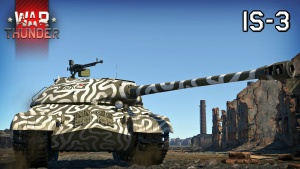
General Gameplay
One of the most important points about the IS-3 is that angling does not work - your pike nose will become easier to get through as you angle your tank, so handle all enemies head-on, if possible. However your gun is still the same 122 mm cannon as on the initial IS-2 at which is situated at a lower battle rating, so it is understandable that you will struggle to penetrate many heavy enemies frontally now at the higher battle rating, even with the new shell that can go through 230 mm of armour at close range.
In the current meta, faster vehicles are more viable than heavier ones, and the IS-3 is at a big disadvantage especially in Realistic. Your armour is amazing in a downtier, but it's basically non-existent in an uptier (to Battle Ratings 8.0 / 8.3, where you start seeing APFSDS and HEAT shells all the time), so knowing when to take this tank out is also a big part of gameplay with it.
Arcade Battles
Surprisingly, the IS-3 can do very well in Arcade. Many enemies in Arcade don't seem to know that the best way to kill the IS-3 with a conventional round is via a shot-trap, so your survivability is increased. Moreover, when fully upgraded, the IS-3 becomes extremely mobile in Arcade allowing you to get into cover after shooting, or quickly advance on an unsuspecting enemy. The best strategy against a single enemy is to just rush them - the terrain usually bounces your tank around slightly making it very difficult to penetrate, and the sheer sight of a heavy tank speeding towards the enemy will cause some panic.
The more experienced tanker will know when to take the IS-3 out in battle and when to use other vehicles. If you know that the game is an uptier (e.g. by checking the statistics tab, or by the map draw) you should decide against the IS-3 and take out a tank like the BMP-1, which fits better into the high tier meta. Also, long-range engagements are a gamble, since your top round and long reload times make it difficult to successfully attack enemies, while they might have a HEAT shell that disregards distance. However, the rush strategy can work here as well, especially if you turn your tank in random directions once in a while, making it harder for opponents to aim at you.
Realistic Battles
In Realistic, the IS-3 is much more difficult to play, because enemies take more time to aim at weakspots and your mobility is toned down. Due to that, you need to take time with your own shots and know your opponents - is there an ammo-rank in the side of the Caernarvon, or should you shoot at the driver's position? and etc. Generally, you need to play with stealth in Realistic, because the person who shoots first is usually the one that gets the kill. Flanking can, and does, work with the IS-3, not because of speed, but because your teammates are shot and you can return fire at the perpetrators and continue your advance. Moreover, some light tanks that are prevalent at the higher Battle Ratings outright cannot penetrate you with their main guns (most of them have ATGMs, though).
Against ATGMs, it's a good idea to use your machine guns to shoot at the ground in front of your tank - this makes a small smoke-screen out of dirt and rubble that makes it difficult for enemies to aim their ATGMs. Keep in mind though, that you should still move your tank away from the initial position, because enemies will try to predict where you are going (it's a good idea to shoot machine guns increasingly to the left, while moving to the right, because it causes a sense of your tank moving with machine guns, while actually, you're moving in the other direction).
General Tips
The IS-3 is relatively versatile, but excels in close-range combat against conventional rounds - it is very good at taking on other heavy tanks such as the T32 and Caernarvon.
- It has a reasonably decent top speed, and on solid ground, acceptable acceleration, allowing it to reach cap points and combat areas fairly promptly and set up in positions to allow it to make the most of the frontal armour.
- When down tiered, the IS-3 performs excellently, able to push forward and play its 'breakthrough' role with impunity.
- Good climbing capabilities allow the IS-3 to reach some surprising positions for sniping or supporting teammates pushing points. Despite the gun's effectiveness being reduced at the range, the armour of the vehicle becomes much more effective as weak spots become significantly harder to hit.
- Since the IS-3 can keep up with most medium tanks like the Centurions, Panthers or T-44s, it can be played as early-game heavy support for those lighter, more vulnerable hulls to assist in taking objectives.
- In up tiered games (7.7-8.3), the IS-3 can come across a lot of chemical rounds and must be played significantly more carefully, as its armour simply cannot compete with the high penetration of these rounds.
Play this tank almost any way that is favourable. A few tips to increase this vehicle's performance:
- Always face towards the enemies directly, avoid exposing the weak hull sides.
- Cover the frontal weak spots if necessary with the gun's large barrel by pointing it downwards. It's better to have the gun barrel destroyed than it is to lose crew members and be potentially unable to reverse out of bad situations.
- Stop only to fire. Movement makes the weak spots harder to target. Even when there is no destination to move to, go back and forth a few meters just so that the IS-3 hull wobbles a bit on start and stop.
- Plan aggressive pushes and movements around enemy locations. The gun has negligible depression and very bad horizontal traverse, making reacting to enemies slow and risky, and impossible if they're on lower ground.
- Avoid engaging vehicles over hills by climbing the hill as it will be hard to aim with only -3° depression and the lower plate will be vulnerable due to the angling.
- Avoid fighting tanks with HEAT/HESH/APFSDS.
- Be careful when brawling at extremely close ranges, as the top of the turret is quite vulnerable due to the vehicle's low profile.
- Avoid facing elevated opponents, as this decreases LOS thickness for hull and exposes turret top.
- Carrying less ammo helps increase survivability from penetrating shots to the turret (ammunition is spread around the edges of the turret).
The Stock Grind
This vehicle can be a pain to play when stock, because enemies will try to kill you in any way, often by setting you on fire 3 times in a row. Your tracks and gun barrel are frequent targets as well, and without Parts or FPE gameplay is going to be painful. Due to this, you must research Parts and FPE first, this is extremely important. Generally, you would want to be behind your teammates, to let them get shot more instead of you, when reloaded you can poke out and shoot your shot, right before going back into the cover or behind teammates. Sniping is an option, but it's not the most viable since there's quite a lot of bullet drop and missing your shots will cause the very long reload.
Pros and cons
Pros:
- Very good frontal armour. Upper and lower plates are basically immune to all conventional shells
- First Soviet heavy tank that comes with the V-shaped hull and ridiculously strong spaced armour lining the sides
- Really strong turret. Even the sides of the turret are heavily armoured and angled
- Very powerful 122 mm gun; top APHE shell has high penetration and very good damage potential
- Good top speed and manoeuvrability
Cons:
- Horrifying reload speed; despite the armour, fighting two tanks at once is ill-advised
- Armour is still no match for APDS and HEAT
- Terrible gun depression; finding a good hull-down location to use the gun is difficult
- Despite the good turret, the left side of the gun mantlet can be penetrated by conventional rounds with good penetration (Like the 88 mm shell found on the Tiger II)
- Bottom of the gun mantlet is an infamous shot trap
- While a small target, the entirety of the turret ring is exposed
- Ammo is strewn throughout the entire crew compartment
- Roof-mounted 12.7 mm machine gun only has a 50 box magazine before needing to reload
- Only four crew members in a small crew compartment; any APHE shell that penetrates will likely knock out the entire crew
- 122 mm gun is the same as the IS-2 with the exception of the new BR-471D shell and will struggle to knock out hull down American mediums and heavies like the M48 Patton and T32
History
Development
Late in 1944, development of the next generation of the IS heavy tanks started, following after the IS-2 tank. The tank was to be better in armour compared to the IS-2 as a response to the new Tiger II that showed up and is able to penetrate the front armour of the hull. The project was codenamed Kirovets-1 and was headed by General Nikolai Dukhov.[1] Design bureaus at the Chelyabinsk Tractor Plant "Tankograd" (ChTZ) and Factory No. 100 worked on the design of the vehicle. A focus on the armour improvement came from a study by an engineer in the teams that most tank losses occurred from hits to the front turret, with the front hull coming in second. The two design bureaus came up with their own ideas on how to make the armour of the tank more effective, with ChTZ developing an extremely rounded turret and No.100 developing a new angled front armour in a shape of a "beak". Soviet command decided that the design should use both features in the armour as both ideas were promising. The prototype vehicle was then produced at ChTZ and completed in October 1944 when it trialled and accepted for production as the IS-3. Production for the IS-3 started in 1945 at ChTZ alongside the IS-2 production. As the first tanks rolled off production lines, it was determined that the design was rushed and unproven with its multiple mechanical problems, some of which included the armour plates welds cracking open from the vibration of cross-country movement and muzzle blast from the gun. Because of this, the IS-3 was not available in large numbers to be committed into battle, leading to their absence in the final months of World War II before Germany surrendered in May 1945.[1]
Despite its rough introduction and prevalent mechanical issues, the IS-3 continued production with gradual fixes to the front hull, final drive, and engine mounts. The Chelyabinsk factory produced IS-3s from 1945 to 1951 for a total of 1,800 tanks.[1]
Usage
Though the IS-3 was not available in large numbers at the start, the Soviets attempted to transport the IS-3 to Germany in April 1945 to assist in the fighting, but they arrived too late to be committed to any fighting. It is reported that the IS-3 did see service during the Soviet invasion of Manchuria in August 1945 to fulfil Stalin's promise in the Yalta Conference to invade Japan after the capitulation of Germany, however not much information is present about this topic.[1]
The end of the most destructive war in history did not waver the Soviet's opinion of the IS-3 however, and the Soviet command had the 52 IS-3 tanks from the 2nd Guards Tank Army paraded in the Berlin Victory Parade on September 7, 1945.[1] The reveal of the IS-3 in the parade came as a huge shock to the Western Allies who saw the IS-3 as a nigh-invulnerable breakthrough tank with their heavy armour. The response to the tank was there to develop their own heavy tanks able to do the same job and with a gun able to fight the IS-3, such as the British Conqueror and the American M103 heavy tanks. Despite its very ominous stature, the IS-3 was still plagued with mechanical issues at this point with its poor armour quality and mechanical reliability. A short modernization program from 1948 to 1952 was made to fix these issues with tanks in production and in the depots with no change to the name designation. The IS-3 was then modernized further in the 1960s to keep it up with changing times. The modifications done were similar to the IS-2M, which gave the IS-3 extra external fuel tanks, storage bins, and protective side skirts as well as an improved engine, engine filtration, new radios, new machine guns, new gun optics, and many more small changes. The modernized IS-3 was named the IS-3M.[1]
One of the few actions the IS-3 saw in the post-war era with the Soviet Union was in 1956 during the Hungarian Revolution with a single heavy tank regiment. The Soviet's heavy tank regiments used to consist of 21 heavy tanks during World War II. In 1947, the regiment composition is changed to between 44-46 heavy tanks and 21 heavy assault guns in a mixed formation. Another change between 1958-1959 saw this mixed unit changed to consist of only heavy tanks but now consists of up to 100 heavy tanks. Despite their armour, a number of heavy tanks were lost before the Soviets were able to crush the revolution. The IS-3 after that did not see much action afterwards in the Soviet Union's hands before it started to be replaced by the newer T-10 heavy tank in the 1960s. During this time, many heavy tanks were transported to the border between the Soviet Union and China in face of the rising tension between the two countries.[1]
The IS-3 would also be supplied to the Soviet Union's allies such as Poland, Czechoslovakia, North Korea, and Egypt. Poland and Czechoslovakia never adopted the tank after trials however, thus leaving only North Korea and Egypt as the main foreign users of the IS-3. The Egyptians used the IS-3M, 100 of which were received from the Soviets, against the Israelis in the Six-Day War in 1967. Of all the tanks used in that war, the IS-3M was the most feared by the Israelis due to the thick front armour. Israeli infantry's standard anti-tank weaponry could not penetrate through the front, and tanks as modern as the M48 Patton also could not defeat the IS-3M. Nevertheless, the better tactics and training among the Israeli tank units were able to prevail against the IS-3M, with the IS-3 being commented by the Egyptians for its low rate of fire and outdated fire-controls to the crew's deficiency in combat. Of the 100, 73 tanks were lost during the Six-Day War. The Israeli managed to capture a number of IS-3 and pressed them into service, though only for a short period before its faults become more problematic than its benefits. The engine on the IS-3 proved to be unsuitable in the desert climate of the Middle East, and an attempt by the Israeli to alleviate this by replacing the engine with one from the T-54, though this did not prove fruitful. In the Yom Kippur War in 1973, both the Egyptians and Israeli used the IS-3M to a smaller degree than the Six Day War, the IS-3 not seeing much combat in the Egyptian forces and were used as dug-in pillboxes on the Jordan River by the Israelis.[1]
Decline and Discontinuation
With the introduction of the lighter and more mobile T-54 main battle tank in the 1950s, the IS-3 saw less usage among the Soviet front-line as it started to become obsolete. Further development to improve and continue the IS tank series became the IS-4, IS-7, and the T-10 tanks. However, in 1960, Nikita Khrushchev, the new premier of the Soviet Union after Stalin died, ordered heavy tank production to be terminated in wake of a new military strategy of missiles rather than conventional forces.[1] His orders are not without reason, heavy tanks are difficult to maintain and transport across the huge Soviet Union, which also did not have many bridges that could support a heavy tank. Another reason was the changing anti-tank technology that made tank armour extremely vulnerable, especially against the new anti-tank missiles that are becoming more and more efficient at their task in destroying tanks. Still, the order did not mean the dissolution of heavy tank units as by 1978, there were still up to 2,300 heavy tanks in the Far East. To this day, many heavy tanks are still either in inactive reserves or dug in as pillboxes along the borders of the Soviet Union.[1] The heavy tank's place in the Soviet Union's military was replaced by the main battle tanks (MBT) like the T-64, which presented a much better firepower, armour, and mobility for only a weight of 35 tons, a technological sign on the rising prevalence of the MBT.
| Archive of the in-game description | |
|---|---|
|
In spite of the fact that the IS-2 lived up to expectations, a decision was made a year after the end of the war to create a tank with even higher characteristics. Its unique welded hull and cast turret construction significantly increased its armour strength in comparison to the IS-2, from which it took many key parts and components. The hull was welded together from rolled armour plates and contained no cast armour pieces. The dual-sloping inclined nose design allowed a driver's hatch to be placed in it, significantly improved visibility in the field and provided high armour strength to the frontal hull. For increased fire safety, its fuel tanks were moved from the fighting compartment to the engine compartment. It was armed with a 122 mm D-25T cannon with a coaxial 7.62 mm DT machine gun. The turret's roof was equipped with a 12.7 mm DShK anti-aircraft machine gun. It had no bow or rear machine guns. At the beginning of their deployment, a range of flaws resulting from a number of design errors and miscalculations was revealed in these tanks. Among other issues, these included failures in the engine, gearbox, and parts of the armoured hull in the region of the engine compartment. In 1948-1952, all IS-3 tanks were reworked and modernised. The engine brackets were reinforced, the gearbox fixings changed, the underturret plate strengthened, the main friction coupling design updated, and the sealing enhanced on the final drive and road wheels. The 10-RK radio set was replaced with the 10-RT radio set. These changes increased the tank's mass to 48.8 tonnes. The first experimental group of IS-3 heavy tanks left their factories in 1945. In total, 2,311 of them were made by mid-1946. They were not deployed in combat in the Great Patriotic War. There are some indications that the IS-3 was used in the defeat of the Japanese army in August 1945. | |
Media
- Skins
- Videos
See also
Links to the articles on the War Thunder Wiki that you think will be useful for the reader, for example:
- reference to the series of the vehicles;
- links to approximate analogues of other nations and research trees.
External links
References
| Chelyabinsk Tractor Plant (Челябинский тракторный завод) | |
|---|---|
| IFVs | |
| BMP-1 | BMP-1 |
| Heavy Tanks | |
| KV | KV-85 · KV-122 |
| IS-1/2 | IS-1 · IS-2 · IS-2 (1944) · IS-2 "Revenge" · IS-2 No.321 |
| T-10 | T-10A · T-10M |
| Other IS Tanks | IS-3 · IS-4M |
| Tank Destroyers | |
| KV Derivatives | SU-152 |
| IS Derivatives | ISU-152 · ISU-122 · ISU-122S · Object 268 |
| Export | |
| IS-2 | ␗IS-2 · IS-2 No.402 · ␗IS-2 (1944) |
| ISU | ␗ISU-152 · ␗ISU-122 |
| IFVs | SPz BMP-1 |
| See Also | Leningrad Kirov Plant |
| USSR heavy tanks | |
|---|---|
| KV-1 | KV-1 (L-11) · KV-1 (ZiS-5) · KV-1E · KV-1S |
| KV-2 | KV-2 (1939) · KV-2 (1940) · KV-2 (ZiS-6) |
| Other KVs | KV-85 · KV-122 · KV-220 |
| IS-1/2 | IS-1 · IS-2 · IS-2 (1944) · IS-2 No.321 · IS-2 "Revenge" · Object 248 |
| Other IS tanks | IS-3 · IS-4M · IS-6 · IS-7 |
| T-10 | T-10A · T-10M |
| Multi-turreted | T-35 · SMK |
| Other | Object 279 |
| Lend-Lease | ▂MK-II "Matilda" |



